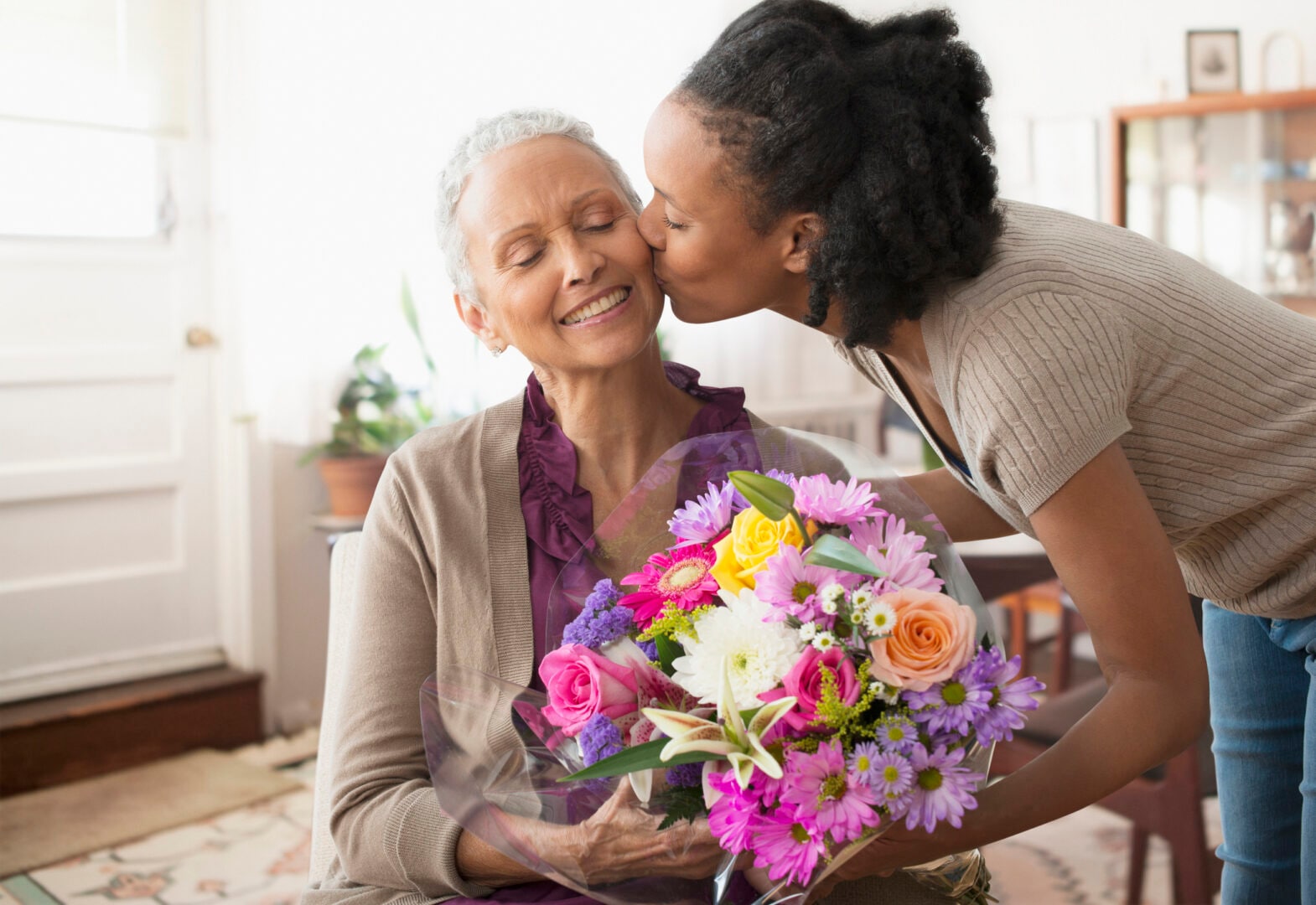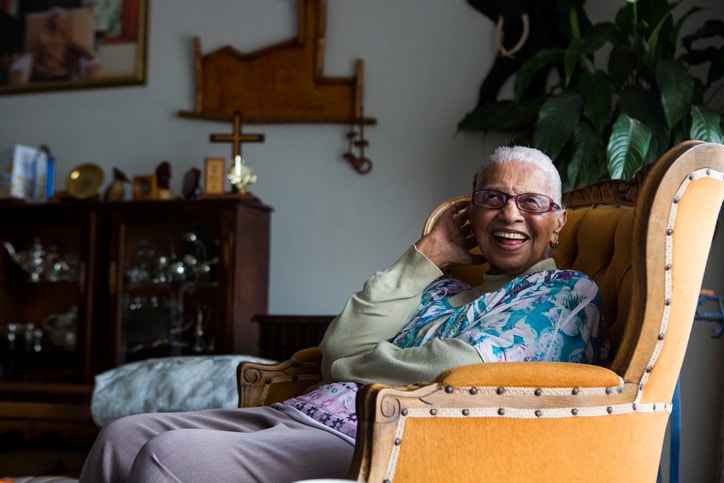Kathleen Leonard, a Houston-based caregiver for her mom, knows caregiver burnout is “a very real thing.” Although she feels fortunate that the 104-year-old is still in her life, she experiences stress and has been burned out “on several occasions.”
Given that her siblings live out of state and she is two blocks away from her mom, the responsibility of managing daily caregiving tasks falls to Leonard, 70. Responsibilities include visiting her mom each day – whether it’s for the two-hour physical therapy appointments or shower nights that are at 8 p.m. sharp, no earlier or later. Although her mother is in very good mental health, the toll of caregiving and feeling like she has to be the glue who holds it all together is a lot.
Leonard’s experience is one that many in the Black community face. While caregiving takes a toll for anyone immersed in it, the physical and mental effects are greater in communities with a majority Black population. According to research from Blue Cross and Blue Shield (BCBS), 43% of Black carers feel isolation and 23% of them experience anxiety.
Unique mental health challenges family caregivers in the Black community face
The mental health of Black caregivers — particularly Black women, who on average provide the majority of unpaid care to their elders — is often overlooked.
Kay Priester, a clinical psychotherapist based in Castro Valley, acknowledges the challenges that arise as a result of not being able to name these hard feelings – to say that the burnout, stress, overwhelm, resentment is an area of struggle. “Once a caregiver is able to say that this is a struggle, they can then begin to water the areas that need attention,” she shares.
For those who live in the same household as the older adult in their care — that’s 57% of Black caregivers, according to BCBS — the generational differences within the home also tend to cause disruption in the collective healing of the family, says Priester.
Younger people, such as Millennials, have more readily available resources and spaces providing conversation around mental health, which in turn makes it easier for them to speak about it, says Priester. By comparison, older generations tend to hold an ingrained belief that “what’s done in this house, stays in this house.” For Black seniors, seeking support from a mental health provider or even admitting there’s a problem in the first place can be a point of contention — and lead to a decline in mental health and well-being for the whole family.
Family caregivers in the Black community are on an emotional rollercoaster
While around half of African American caregivers feel they didn’t have a choice in taking on the role, most shared they were able to find meaning or sense of purpose, according to research from AARP.
“I never felt resentment,” says Maureen Williams, a caregiver from West Hills, California, who cared for her mother who’d been diagnosed with dementia. “She was my mom. She was always there for me. If I was sick, she would be right there.”
Also a licensed clinical social worker, Williams acknowledges the emotional impact of her personal caregiving experience. “When you have a parent who has memory loss, you lose them before you physically lose them, and that was hard,” she notes.
It’s an emotional process, shares the 50-year-old, recalling the worry over whether she was doing enough and if she could be doing more.
The worry is something Leonard, who lives a short walk from her mother, says is always there. “I love my mother, but it doesn’t minimize the stress,” she points out.
One of the greatest challenges: the anxiety and guilt that strike when she’s not with her mom physically, such as when she visits her grandchildren who live in New York. As a result, she limits her trips — and admits that she can’t really relax and enjoy the time away.
How caregiving affects work and adds financial strain
In families in which a person is serving as both a caregiver and the sole provider for the household, mental wellness becomes even more difficult. AARP findings show that most African American caregivers work while caregiving, and many report some sort of impact on their work, whether it’s getting in late, having to leave early or taking time off to provide care.
Maureen Williams knows firsthand how tough it is to juggle these two roles. Although she didn’t have the option to take a long leave of absence, it became increasingly difficult to stay present at work when she was getting calls from her mother’s caregiver. “It was a really emotional time for me,” notes Williams. “I did take time off towards the end, but that was hard, too, because I knew I had a lot of people at work depending on me.”
According to 2020 data from AARP, African American caregivers report about 2.4 financial impacts as a result of providing care, which is more than either non-Hispanic white or Asian caregivers. These most commonly include putting the brakes on saving, leaving bills unpaid, or paying them late or taking on more debt.
Adding to the already heavy load, the pandemic widened the economic divide. A lot of Black workers lost their jobs or were unable to sustain income with big cuts in hours, and when you’re the sole breadwinner or the one bringing in the brunt of income for your home, this adds to the strain of being a caregiver, says Priester.
“I had to set boundaries at work and say ‘no’ to certain things like increasing my workload when my mom’s health had significantly declined.”
— Maureen Williams, caregiver
How to navigate these struggles
Here, our experts offer various tips on what Black carers can do to improve their overall outlook:
1. Show yourself compassion
Self-care is usually discussed as a blanket concept, but it is unique and individual to each person. “It requires that we take the opportunity to be honest with ourselves — and with our families — and take a step back when we need to,” points out Priester.
Leonard shares that she finds relief through various fitness classes, which offer her a way to release some of the stress that she feels. Her routine consists of two hours of exercise — utilizing YouTube for combo training/cardio workouts as well as Pilates and rowing at a studio — six days a week. “It really helps,” she says. “I do it first thing in the morning, so that I can be available if Mom needs me the rest of the day.”
2. Set boundaries
Creating mental and physical boundaries in the various facets of your life is key, says Williams. Begin to notice the areas where you’re overextending yourself and where you can begin to say no or not right now.
“I had to set boundaries at work and say ‘no’ to certain things like increasing my workload when my mom’s health had significantly declined,” she notes.
At the same time, setting boundaries at home and as a caregiver helped to better allow her to be present for her kids. For instance, Williams recalls that when she was working or trying to get a handle on things at home, she became more discerning about the calls she would take from her mom’s caretaker, noting that as long as it wasn’t an emergency, she would simply call her back.
3. Create a support system
It’s also crucial to find a support group in which you can share and be heard. Facebook groups or community centers are a great place to start. You can also utilize organizations like the Caregiver Action Network (CAN), a nationwide nonprofit that offers support to all types of caregivers.
According to Williams, being in community with those who can relate is crucial, because even though you will encounter well-meaning people who try to empathize, if they’re not in the same boat, it can be tougher for them to truly understand what you’re going through.
If a support group isn’t for you, individual therapy would be beneficial, says Williams. As a caregiver who’s carrying the brunt of the responsibilities, and giving a great deal of time and energy to an older loved one’s care, it’s normal for feelings of resentment, anger or burnout to develop, talking to a mental health provider can help you navigate these feelings.
4. Have empathy
Empathy goes a long way, as it can help you recognize and hold space for the range of emotions everyone in the household may be feeling. For caregivers living in a multigenerational household, Priester says that collective healing and support begins with conversation.
To foster these discussions, she has families create a genogram — a visual representation of their family tree. You can start with two generations, and as you work through the exercise, you’ll notice the questions it naturally brings about.
“From what I’ve seen, older generations and elders have been able to share stories because they are reminded of the journey within their families, within their blood lines,” recounts Priester. “Family members can better learn about each other, while opening the door for deeper conversations.”
5. Know your rights and options for resources
There are a number of federal and state options to help in securing aid for a family senior care provider. It’s also important to have a good understanding of the Family and Medical Leave Act (FMLA), as well as the Americans With Disabilities Act (ADA), which help you to know the legal rights you have when it comes to taking time off and in identifying any discrimination you may be facing. Here are some additional resources to check out:
- AARP Caregiving offers resources, programs, as well as discounts on various services for seniors and caregivers.
- Family Caregiver Alliance offers free resources to provide caregivers with support, tailored information and tools to manage the complex demands of caregiving.
- The U.S. Department of Labor has fact sheets that explain things like FMLA and more.
- The National Respite Locator helps caregivers locate programs, providers, and funding by location.
- Individuals in need living with cancer, chronic disease, and life-altering diseases can access Good Days for patient assistance and financial resources for life-saving and life-extending treatments.





